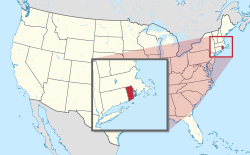Stephen Northup family
In 1645 Stephen Northup emigrated from Great Britain to New England. He became the Town Sergeant of Providence in 1660, and took an Oath of Allegiance on 19 May 1671 in Kingstowne. Stephen Northup Jr. was born 1660, the first son of Stephen Northup Sr. Stephen Northup Sr. lived at North Kingston but conflicting records have him living in Providence at the same time. [4]
He was granted a plot of land (25 acres) on October 2, 1655, by the "Towne Meeting of Providence, R.I." At another "Towne Meeting" on Aug 27, 1656, he was granted commonage equal to any other townsman, the right to vote, the right of being a "freeman" and proprietor in the town of Providence. On February 8, 1662, Northup Sr. sold a plot of land (possibly that same 25 acres) in the Providence region and moved to Kingstowne. [4]
What is known is the Northup family started with the seniors marriage to Sarah Elizabeth Harrington in about 1654, and gave birth to their first child (Stephen Jr.) in 1660 with records indicating birth in the town of Kingstowne (North Kingstown) and Providence. Stephen Sr. officially moved to Kingstowne in 1662 but clearly had an established residence in place since his second son, Benjamin, was born that same year in the town of North Kingstown (according to town records). The likely scenario of events to help to accurately date this home is to project that Stephen Sr. acquired the North Kingstown property at, or around, the year of 1660 with the intention of moving his new family there. However, his official record of North Kingstown residency is not until 1662. With these facts at hand, one can surmise that during this two-year period, Northup prepared his North Kingstown property for construction of his home completing it early 1662. This places the actual beginning construction of the Stephen Northup House within the time period of 1660, or 1661. [4]
This page is based on this
Wikipedia article Text is available under the
CC BY-SA 4.0 license; additional terms may apply.
Images, videos and audio are available under their respective licenses.



